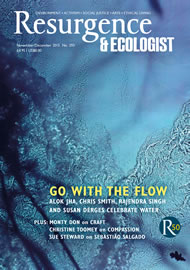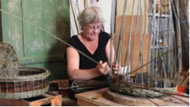Last November, at the annual Crux Craft Fair in Devon’s Rattery Village Hall, I found what I had been searching years to find: a large and very solid willow basket, amongst a beautiful display of baskets of all shapes and sizes. Better still, I enjoyed my first encounter with their maker, Hilary Burns. Hilary is a true craftsperson who takes time for the whole process of basket-making. As the widow of the potter Noel Cousins, I know how much time many of the crafts take. As a therapist who works through the arts with the youngest traumatised children, I know that time really is as long as it takes!
Elinor Goldschmied, my good friend and a pioneer in early childhood education and therapy, shared that attitude with me. She was the creator of a specially made treasure basket for her ‘training’ film Infants at Work. Like Elinor’s basket-maker, Hilary begins at the beginning. She grows and cuts willow at her Dartington field, within sight of where Elinor lived and worked. Then she grades, bundles and stores the willow until it has seasoned so that the smell, textures and colours remain. As Elinor said, “natural willow baskets reflect the richness of Nature itself.”
But who was Elinor Goldschmied, and why were all those sensorial experiences so important for her and for the development and learning of babies?
Elinor Goldschmied (nee Sinnott) was born in 1910 into a prosperous professional English family in rural Gloucestershire. Their large garden had adjoining fields, woods and beautiful countryside all around, and Elinor said: “Nature gave me comfort when I lost a favourite brother and then my mother at an early age… [W]e should never deny the impact of our childhood experiences either on our own lifelong development or on our professional thinking about young children.” At the age of 18 she went to Froebel College in London to train as a nursery teacher but found the state system of education too restrictive. She felt that confining large numbers of pupils in classrooms surrounded by hard playgrounds was far too unnatural, so she went instead to become a house mother at the progressive Dartington Hall School in Devon. The Froebelian philosophy of enabling young children to learn and develop in gardens and through play was in tune with her own beliefs.
In the 1930s Dartington also provided Elinor with a very exciting artistic, cultural and political environment. The nursery was surrounded by wild gardens, fields and woods reminiscent of her childhood home. Elinor also took part in the making of films and hoped to take that work further. It was here that the seeds for her next steps in life were sown. Her close observations of babies and young children in more natural environments compared to those in the slums of London led to a greater interest in justice and fairness. Elinor was determined to bring about change. In 1937 she won a scholarship for a mental health course at the London School of Economics, where she qualified as a psychiatric social worker. It was here that she met and married Guido Goldschmied, a lawyer. War broke out shortly afterwards, and Elinor went to Bradford to take charge of a home for “very disturbed children who were unbilletable because they were so wild… [M]any were Jewish refugees who had been transported without their families [and] some were orphans… [C]an you imagine what that must have been like for them?”
In those exceptional circumstances Elinor closely observed the changes in those children when they were given a special ‘key person’ to relate to and help them to settle. They began to make friends and adjust to new routines and freedom. It was here that Elinor used her own experiences of loss and helped the children to experience natural beauty. As well as changing the home indoors, she turned to Nature to develop a garden with them to help their healing. This experience laid the foundations for all Elinor’s future work in reorganising childcare institutions in Britain and in Italy.
After Guido died tragically young in 1951, Elinor moved with their baby son Marco to Milan to be with a sister. She became the director of a large orphanage for illegitimate babies, set up by Mussolini, where the rules were more like those of a place of punishment for “naughty mothers … and very distressed or silently traumatized infants”. Elinor picked up the threads of her psychological studies of the crucial importance of “relatedness to key persons”. She also resumed her creative life as a film-maker and made her first films of babies taken out of their cots to reawaken all their senses and experience the world around them. Once again Elinor emphasised the importance of Nature for the holistic and healthy development of babies. She filmed those infants gradually gaining the confidence to explore the natural objects placed at first on the floor near them and then in “treasure” baskets or to be found by them as they played and explored in the garden. These films were used politically to influence many of the changes in the institutional care of babies in Italy. They are now in the Froebel Archive at the University of Roehampton, London.
When Elinor returned to London in 1955 to continue her psychological studies with Professor John Bowlby, she became a senior social work inspector with the old London County Council and then the Inner London Education Authority. Eventually she became a consultant with the National Children’s Bureau to collaborate with others to write books and resume making or directing educational films with child psychologist Anita Hughes. These are still used for the training of nursery staff. Her “treasure baskets for seated babies” and “heuristic or discovery play” with older infants were, in her opinion, the most significant work in her life.
Elinor’s search for the correct baskets began at that time. None of the mass-produced baskets provided the babies with the sensorial experiences, sturdiness or safe comfort they needed in order to explore freely. While domestic baskets can be much smaller, Elinor insisted that the group baskets be at least 18 inches in diameter and 5 inches high, with a firm base and with a smooth top for the babies to lean on. Each basket had to be filled to the brim, by the babies’ families and nursery staff together, with natural materials and simple, safe, inexpensive and interesting objects that would give the babies many opportunities for unhindered exploration through their senses. Some babies simply watched, while others explored energetically or with sustained concentration. The adults played an important part by sitting within sight of their infants but without talking to them or interrupting their natural curiosity, which Elinor regarded as the basis of real learning.
Much of Elinor’s pioneering work on the brain has been used in recent years to observe, diagnose and assess identifiable developmental difficulties in babies and to test current neurological theories.
Now that I have found Hilary and a young local film-maker, Jon Merriott, we will be able to take Elinor’s work and our learning about infants even further. We have started to make a film, Whispering Willows Treasure Baskets. So far it shows Hilary amongst her willows and engaged in the basket-making process. She has just finished weaving the first of our beautiful baskets, and at our autumn celebration of the life of Elinor Goldschmied we will have a special Treasure Basket party to start to fill them. I wonder whether we will find Elinor’s total of 100 objects with “no plastics!”
For more information about the basket-maker Hilary Burns, visit www.hilaryburns.com








